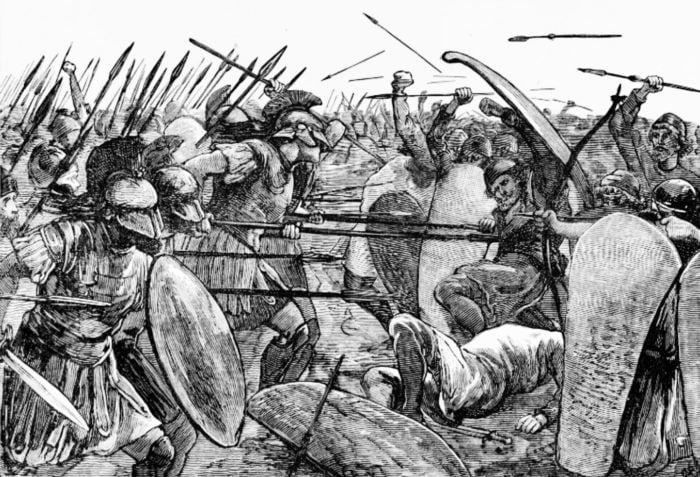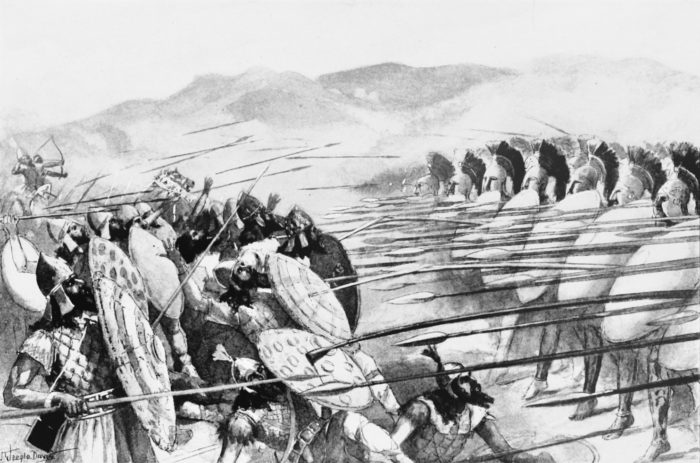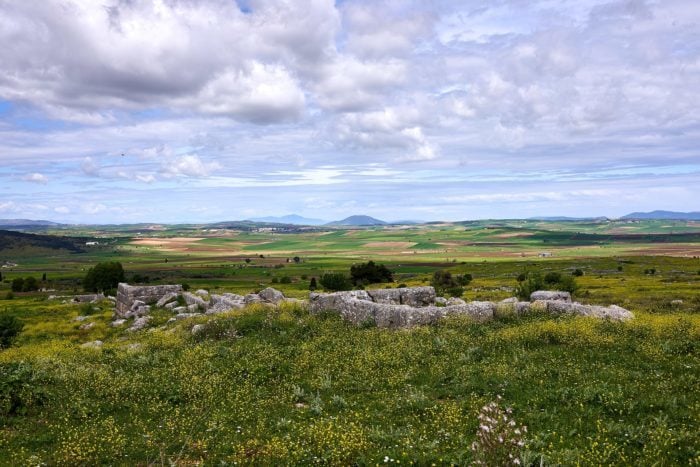
Today, on August 27, 479 BCE the Greek warriors annihilated and put an end to Persian ambitions at the Battle of Plataea.
This ferocious battle was the final clash of the second Persian invasion of Greece with the victory of the allied Greek forces putting a final end to the Persian empire’s expansion.
This decisive battle occurred in the city of Plataea in Boeotia and was fought between an alliance of Greek city-states, including Sparta, Athens, Corinth, Megara, and others against the Persian army of Xerxes I along with a large number of pro-Persian Greeks, mainly from Thebes. Plataea was an ancient city located in southeastern Boeotia south of Thebes.
The previous year, the invading Persian force, led by the Persian king himself, had scored victories at the Battles of Thermopylae and Artemisium and conquered Thessaly, Boeotia, and Attica.
However, at the ensuing Battle of Salamis, the Allied Greek Navy had won an unlikely yet total victory, therefore preventing the conquest of the Peloponnese.
Xerxes then retreated with most of his army, leaving his general, Mardonius to finish off the Greeks the following year. After all, the Persians controlled a big part of Greece, and their army was essentially intact.
Greeks assemble allied army to kick out Persians
In the summer of 479 BC, the Greeks assembled a huge allied army, marching out of the Peloponnese to push the Persians out once and for all.
According to Herodotus, the Greek hoplite forces for the Battle of Plataea were divided as follows: 8,000 Athenians; 5,000 Corinthians; 5,000 Lacedaemonians; 5,000 Spartans, 3,000 Megarians; and 3,000 Sicyonians.
There were: 1,500 Tegeans; 1,000 Phleiasians; 1,000 Troezenians; 800 Anactorians/Leucadians; 800 Epidaurians; 600 Orchpmenians; 600 Plataeans; 500 Aeginetans; and 500 Ambraciots joining them.
A total of 600 Eretrians/Styrians; 400 Chalcidians; 300 Hermionians; 300 Potidaeans; 200 Lepreans; 200 Paleans, and an unspecified number of Thespians joined these forces, totaling 38,700 hoplites.
The Persian forces at Plataea
Although the historian Herodotus did not provide specifics on the Persian Army for the Battle of Plataea, the numbers are estimated to have come to 110,000.
Τhe Persian forces were divided into units of various nationalities with their estimated numbers showing 40,000 Persians, 20,000 Medes, 20,000 Bactrians, Indians, and Sacae.
There were also 50,000 pro-Persian Greeks, mostly Thebans, accounting for a total of 110,000 troops with a combined cavalry force 5,000 strong.
Upon the approach of the Greeks, the Persian forces retreated to Boeotia and built a fortified camp near Plataea.
The Greeks, who had no cavalry at all, refused to be drawn into the prime cavalry terrain around the Persian camp.
Battle of Plataea strategies
The Persian general, Mardonius, was confident that the outnumbered Greeks were easy prey for his vast army and were potentially divided.
Persian warfare favored long-range assault using archers followed up with a cavalry charge while Greek warfare was based on heavily-armored hoplites fighting in tight formation at least eight men deep, called the phalanx.
Each hoplite carried a heavy round bronze shield and fought at close quarters using spears and swords.
The Persian infantry, on the other hand, carried lightweight wicker shields and were armed with a long dagger or battle ax, a short spear, and composite bow.
In addition, the Persian forces included the Immortals, an elite force better protected with armor and armed with spears.
The Persians also had a cavalry armed with bows and an additional two javelins for throwing and thrusting. The horsemen attacked on the flanks of the main battle, causing the opposing infantry to land into disarray after the repeated salvos from the archers.
The Greeks, knowing that the Persians preferred open terrain for the way they fought—with archers and cavalry—chose the advantages of broken terrain.
In addition, the light arrows of the Persian archers were hardly effective against the heavy armor and shields of the Greek hoplites.
Fighting at close quarters with the heavy armor, longer spears and the rigid discipline of the phalanx formation meant that the Greek hoplites would have an advantage on broken terrain.

The Battle of Plataea
The Greek forces moved into position, forming a 7 km (4.3 miles) long front just 3-4 km opposite the Persians below the low hills of Cithaeron.
Mardonius lined up his army with the Persians holding the right flank, and the Medes and the Bactrians, Indians, and Sacae in the center. On the left flank, he lined up the pro-Persian Greeks.
The cavalry forces waited slightly back, one group on each flank.
On the opposite side, the Spartans, Tegeans, and Thespians held the right flank and the Athenians, Megarians, and Plataeans held the left flank, with everyone else in the center.
Once in position, the two armies waited with each side remaining in their preferred terrain: the Persians on the plain and the Greeks in the broken terrain near the hills.
After two days of a stand-off, the Battle of Plataea began with Mardonius sending in his cavalry to attack the side of the Megarians and Athenians. The Athenian archers helped the Greeks to hold their lines.
In the attack, the Greeks managed to kill the Persian commander, Masistius, thus boosting the morale of their forces.
After this slight victory, the Greeks advanced to the northwest just south of the river on the Pyrgos ridge, to obtain a better water supply, but Mardonius did not respond.
Both sides then held position for another week or so with both remaining on their advantageous terrain, as no commander wanted to risk battle on unfavorable terms.
Mardonius then sent his cavalry on a mission around the right flank of the Greek forces where the supply column was situated.
The Persians slaughtered the poorly-armed Greeks and burnt the supplies, dealing a heavy blow to the hoplites by cutting off their food and water.
The Spartan General Pausanias, in order to to reach a water supply under the cover of darkness, moved the Greek center back to the base of the Cithaeron hill just in front of Plataea.
After two days, Mardonius unleashed his cavalry in a full frontal attack on the Greek lines. At the same time, the Persians blocked access to the Gargaphia spring which was the Greeks’ main source of water.
The Greek battle-line fragmented and seemed to be in full retreat. Mardonius ordered his forces to pursue them and finish them off.
At this point, the cavalry had withdrawn, probably to rearm themselves with fresh arrows. The Persian foot soldiers tried to chase the retreating Greeks.
Instead, however, the Spartans, Athenians, and Tegeans halted and counter-attacked, routing the lightly-armed Persian infantry and managing to kill Mardonius, after a Spartan hoplite Arimnestus simply hurled a rock at him.
The remnants of the Persians were forced back across the river in disarray. However, the pro-Persian Theban cavalry intervened and allowed them to reoccupy their fortified camp.
The pro-Persian Greek hoplites on the right flank were also forced to retreat under pressure from the Athenians, taking up position behind the walls of Thebes.
The Athenians, Spartans, and Tegeans then stormed the Persian camp, causing more heavy casualties amongst the invaders, slaughtering many, and forcing the rest to flee.
The destruction of the invading army, and the remnants of the Persian navy—apparently on the same day at the Battle of Mycale—put an end to the Persians’ ambitions to take over Greece.
The Greeks then turned to Thebes and stormed and sacked the city, punishing the Thebans for siding with the Persian invaders.
Aristodemus redeems himself in Plataea
Among the victorious Greeks, there was one Spartan hoplite, Aristodemus, who had survived the Battle of Thernmopylae. He did not die alongside King Leonidas and his brave 300 Spartans.
His returning to Sparta alive while all his fellow warriors were killed in battle was the ultimate act of treason for Spartans.
The coward was not punished, but he was treated as if he did not exist; he was invisible and no one would touch him.
According to Herodotus, before the heroic battle, Aristodemus and Eurytus had been stricken by an eye disease and became blind. King Leonidas deemed them unfit to fight and ordered them to return home before the battle.
Eurytus, however, turned back to the battlefield, and though literally blind, met his valiant death very early on in the battle.
Aristodemus, who duly returned to his homeland, was regarded as a coward and subjected to humiliation. He was even called “Aristodemus the Coward” from then on.
Herodotus believed that had both Aristodemus and Eurytus returned to Sparta alive, or Aristodemus alone been ill and excused from combat, the Spartans would have ascribed no blame to him.
To redeem himself and shed the stigma of being a coward, Aristodemus chose to seek a glorious death at the Battle of Plataea only just one year after Thermopylae.
There, it was recorded that he fought fiercely and bravely, desperately trying to get rid of his shame and clear his name.
His courage and bravery did not go unnoticed. Unfortunately for him, however, the military leaders also saw a recklessness that was completely incompatible with the discipline required for the success of the Spartan phalanx.
Every move outside the battle plan was viewed as jeopardizing the lives of fellow warriors.
Once again, Aristodemus was in a difficult position and was forced to apologize for his stance. Although very seriously injured in the battle, he was deemed insane.

Aftermath
Although the Battle of Plataea was in every sense a decisive victory, it has not been attributed the same significance as the victory at the Battle of Marathon, the victory in Salamis, or even the Allied heroic defeat at Thermopylae.
With the Plataea victory, the Greeks had sent a message to Xerxes that Greece would not allow herself to be subjugated to any foreign invader.
The victories at Marathon, Salamis, and Plataea had ensured the survival of Greece and allowed for Greek civilization to flourish and become the foundation upon which all Western cultures would be based.
See all the latest news from Greece and the world at Greekreporter.com. Contact our newsroom to report an update or send your story, photos and videos. Follow GR on Google News and subscribe here to our daily email!



